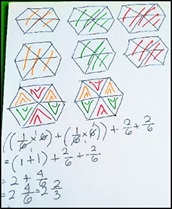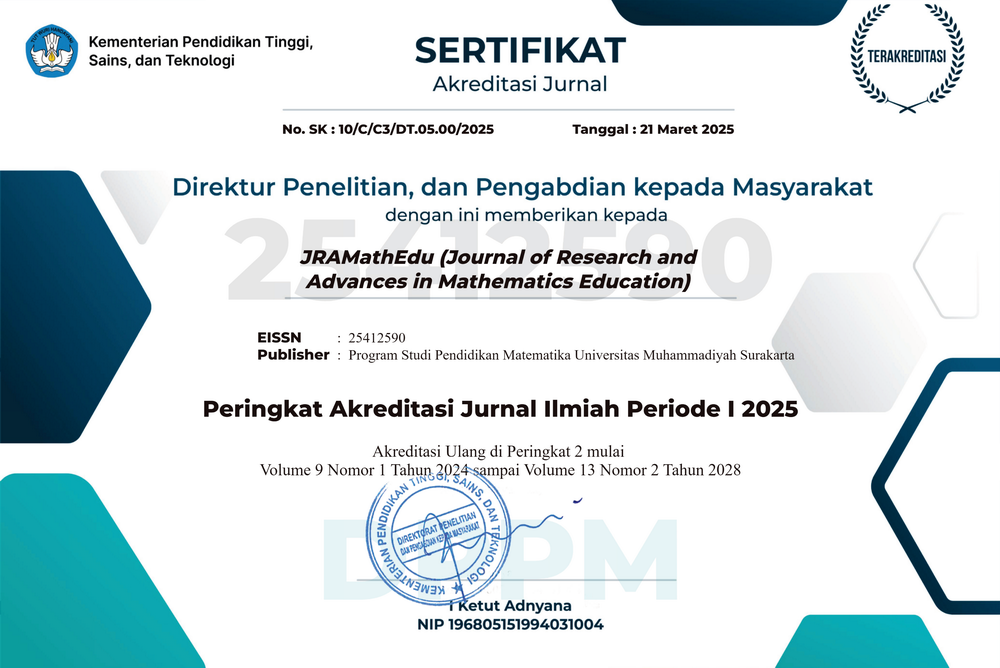How is the elementary students' creative thinking process in solving fraction problems using geometric and algebraic solutions?
DOI:
https://doi.org/10.23917/jramathedu.v8i3.3357Keywords:
creative thinking process, problem-solving, fraction, geometric solution, algebraic solutionAbstract
This study aimed to explore students’ creative thinking process in fifth- grade elementary school in fraction problem solving based on gender differences. Subjects consisted of one male and one female with high mathematical ability. Data were collected by task-based interviews and analyzed through the sequence: data classification, data reduction, data presentation, interpretation, and conclusions. The creative thinking process in this research is a series of stages that students go through in creative thinking, including: exploring facts, identifying problems, generating ideas and completing ideas to produce solutions. By these stages, the subjects produced solutions in geometric and algebraic that showed their creative thinking that fulfilled fluency, flexibility and novelty. The subjects used algorithm solutions by repeating the completion steps. In this research, both subjects related their algebraic solutions with geometric solutions that has been produced. It was found that geometric solutions supported the subjects to deliver algebraic solutions and they related their understanding of fractions concepts to solve the problem. The more students’ knowledge or experiences associated with the problem, the more ideas for solutions they found. In this research, it was also found that there were some similarities and differences between the creative thinking processes of both subjects.
References
Agustini, R.Y.et al. (2017), Construction of Open-Ended Problems for Assessing Elementary Student Mathematical Connection Ability on Plane Geometry. J. Phys. Conf. Ser., 895 (1). doi: 10.1088/17426596/895/1/012148
Bakir, S. & Oztekin, E. (2014). Creative Thinking Levels of Preservice Science Teachers in Terms of Different Variables. Journal of Baltic Science Education, 13(2), 231-242.http://www.scientiasocialis.lt/jbse/files/pdf/vol13/231-242.Bakir_JBSE_Vol.13_No.2.pdf
Behr, M.J., Harel, G., Post, T. and Lesh, R. (1992). Rational Number, Rasio and Proportional. Handbook of Research on Mathematics Teaching and Learning. New York: Macmillan.
Betancourt, J., Valadez, M. L. D., Rodríguez-Naveiras, E., Flores, J. F., & Borges, Á. (2022). Differences between Creativity and Gender in Students with High Abilities Attending a School with Total Grouping. Children (Basel, Switzerland), 9(7), 1081. https://doi.org/10.3390/children9071081
Bragg, Leicha A. & Nicol, Cynthia. (2011). Seeing Mathematics through a New Lens Using Photos in the athematics Classroom. Australian Mathematics Teacher, 67(3), 3-9. https://files.eric.ed.gov/fulltext/EJ943723.pdf
Evans, James R. (1991). Creative Thinking in the Decision and Management Sciences. Dallas: College Division South Western Publishing Co.
Haylock, D. (1997). Recognising mathematical creativity in school children. Zentralblatt fuer Didaktikder Mathematik, 29(3), 68-74. https://www.emis.de/journals/ZDM/zdm973a2.pdf
Holmes, E.E. (1995). New Directions in Elementary School Mathematics (Interactive Teaching and Learning). Columbus: Englewood Cliffs
Hong, E. & Milgram, R.B. (2010). Creative Thinking Ability: Domain Generality and Specificity. Creativity Research Journal, 22(3), 272-287. https://doi.org/10.1080/10400419.2010.503535
Hooijdonk, Mare Van, et. al. (2020). Creative Problem Solving in Primary Education: Exploring the Role of Fact Finding, Problem Finding, and Solution Finding accross task. Thinking Skills and Creativity, 37, Article 100665, 1-10. https://doi.org/10.1016/j.tsc.2020.100665
Hunt, E.B., Lunneborg, C.,& Lewis, J. (1975). What Does It Mean to be High Verbal? Dalam Cognitive Psychology, 7, 194-227.
Isaksen, Scott G. (1995).CPS: Linking Creativity and Problem Solving. In G. Kaufmann, T. Helstrup, & K.H. Teigen, (eds.) Problem Solving and Cognitive Processes: a festschrift in honour of kjell raaaheim (pp. 145-181). Berggen sandviken, Norway: Fagbolforlaget Vigmostad & Bjorke AS.
Isaksen, S.G., & Treffinger, D.J. (2004). Celebrating 50 years of reflective practice: Versions of creative problem solving. The Journal of Creative Behavior, 38 (2), 75-101. https://doi.org/10.1002/j.2162-6057.2004.tb01234.x
Isaksen, S. G., Dorval, K. B., & Treffinger, D. J. (2011). Creative Approaches to Problem Solving: A framework for Innovation and Change. CA: Thousan Oaks.
Krulik, Stephen & Rudnick, Jesse A. (1999). Innovative Tasks to Improve Critical and Creative Thinking Skills. In Stiff, Lee V. & Curcio, FrancesR. (1999) Developing Mathematical Reasoning in Grade K-12. Reston, Virginia: NCTM.
Lau, J. Y. (2011). An introduction to critical thinking and creativity: Think more, think better. John Wiley & Sons. https://doi.org/10.1002/9781118033449
Lee D, Son T. (2021). Structural connectivity differs between males and females in the brain object manipulation network. PLoS One, 16(6):e0253273. doi: 10.1371/journal.pone.0253273. PMID: 34115811; PMCID: PMC8195422.
Namkung, J & Fuchs, L. (2019). Remediating Difficulty with Fractions for Students with Mathematics Learning Difficulties. Learning Disabilities: A Multidisciplinary Journal 24(2), 36-48. https://doi.org/10.18666/LDMJ-2019-V24-I2-9902
Orton, Anthony. (1992). Learning Mathematics. Issues, Theory and Classroom Practice. Second Edition. Great Britain: Dotesios Ltd. Trowbridge, Wilts.
Ramdani, A. et al. 2021. Enhancing prospective teachers’ creative thinking skills: A study of the transition from structured to open inquiry classes. Jurnal Cakrawala Pendidikan, 40 (3): 637-649. doi: https://doi.org/10.21831/cp.v40i3.41758.
Reilly, D., Neumann, D. L., & Andrews, G. (2017). Gender differences in spatial ability: Implications for STEM education and approaches to reducing the gender gap for parents and educators. In M. S. Khine (Ed.), Visual-Spatial Ability: Transforming Research into Practice (pp. 195-224). Switzerland: Springer International. doi: 10.1007/978-3-319-44385-0_10
Reinhold, F., Hofer, S., Berkowitz, M. et al. (2020)The role of spatial, verbal, numerical, and general reasoning abilities in complex word problem solving for young female and male adults. Math Ed Res J 32, 189–211. https://doi.org/10.1007/s13394-020-00331-0
Reys, R. et.all. (1998). Helping Children Learn Mathematics. USA: Allyn and Bacon.
Ritter, S.M. & Mostert, N. (2017). Enhancement of Creative Thinking Skills Using a Cognitive-Based Creativity Training. J Cogn Enhanc 1, 243–253. https://doi.org/10.1007/s41465-016-0002-3
Santrock. (2009). Psikologi Pendidikan. Educational Psychology. Edisi 3. Buku 1. Jakarta: Salemba.
Siswanto, R.D. et al (2023). Creative Thinking Process in Solving Mathematical Problems Geometry Topics In Terms of Students' Spatial Abilities. International Journal of Progressive Sciences and Technologies, 36(2): 544-550. doi: http://dx.doi.org/10.52155/ijpsat.v36.2.5004.
Siswono, T.Y.E. (2008(1)). Proses Berpikir Kreatif Siswa Dalam Memecahkan dan Mengajukan Masalah Matematika. Jurnal Ilmu Pendidikan, 15(1), 60-68. http://dx.doi.org/10.17977/jip.v15i1.13
Siswono, T.Y.E. (2008(2)). Model Pembelajaran Matematika Berbasis Pengajuan dan Pemecahan Masalah Untuk Meningkatkan Kemampuan Berpikir Kreatif. Surabaya: Unesa University Press.
Silver, Edwar A. (1997). Fostering Creativity through Instruction Rich in Mathematical Problem Solving and Problem Posing. ZDM International Reviews on Mathematical Education Articles, 9(3), 75-80. https://www.emis.de/journals/ZDM/zdm973a3.pdf
Singh, P., Hoon, T. S., Nasir, N. A. M., Han, C. T., Rasid, S. M. & Hoong, J. B. Z. (2021). Obstacles Faced by Students in Making Sense of Fractions. The European Journal of Social & Behavioural Sciences, 30(1), 34-51. https://doi.org/10.15405/ejsbs.287
Sokić, K., Qureshi, F., & Khawaja, S. (2021). Gender Differences In Creativity Among Students in Private Higher Education. European Journal of Eduacation Studies, 8(11), 87-103. https://oapub.org/edu/index.php/ejes/article/view/3974
Sternberg, R. J. (2000). Thinking: An Overview. Dalam A. Kazdin (Ed.), Encyclopedia of Psychology (Vol. 8, pp. 68-71). https://doi.org/10.1037/10523-029
Sternberg, R. J. (2007). Wisdom, intelligence, and creativity synthesized. New york: Cambridge University Press.
Sternberg, R. J. (2008). Psikologi Kognitif Edisi Keempat diterjemahkan oleh Yudi Santoso. Yogyakarta: Pustaka Pelajar.
Travers, John F. (1979). Educational Psychology. New York: Harpers & Row, Publishers.
Treffinger, D. (1995). Creative problem solving: Overview and educational implications. Educational Psychology Review, 7(3), 301-312.https://doi.org/10.1007/BF02213375
Treffinger, D. J., Selby, E. C., & Isaksen, S. G. (2008). Understanding indvidual problem-solving style: A key to learning and applying creatve problem solving. Learning and Individual Differences, 18(4), 390-401. https://doi.org/10.1016/j.lindif.2007.11.007

Downloads
Submitted
Published
How to Cite
Issue
Section
License
Copyright (c) 2024 Septi Triyani

This work is licensed under a Creative Commons Attribution-NonCommercial 4.0 International License.


















